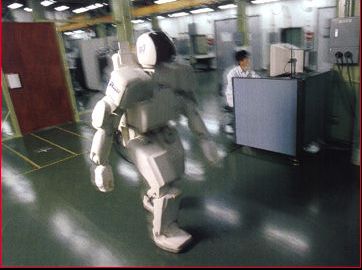


Ten
years and tens of millions of dollars in the making, the Honda P3 strides
down its course at the car company's secret research facility on the outskirts
of Tokyo. The product of a costly decade-long effort, the Honda robotic
project was only released from its shroud of corporate secrecy in 1996.
In a carefully choreographed performance, P3 walks a line, opens a door,
turns a corner, and after a safety chain is attached, climbs a flight
of stairs. Despite its mechanical sophistication, it can't respond to
its environment. If people were to step in its way, the burly robot would
knock them down without noticing them. Ultimately, of course, Honda researchers
hope to change that. But, in what seems an attempt to hedge the company's
bet, P3's senior engineer Masato Hirose is also working on sending the
robot to places where it cannot possibly injure anyone.. In the future,
he hopes, the robot will be rocketed to distant planets, to remotely explore
places human beings cannot yet visit.
Origin
of Name
Prototype 3
Purpose
To cultivate a new dimension in mobility as an automobile
company
Height
1.6 m
Weight
130 kg
Maximum Walking Speed
2 km/hr
Vision
Digital video cameras
Sensors
Gyrometer, G-Sensors,
6-Axisforce sensors on wrists and feet
Batteries
Ni-Zn batteries, 25 minute duration
External Power
DC 136v
Project Status
Ongoing
Information Source
Noriko Okamato


